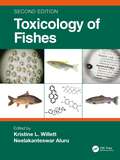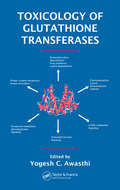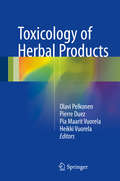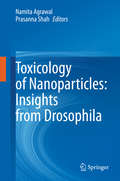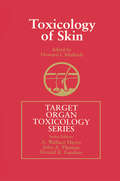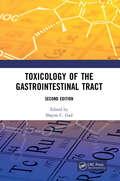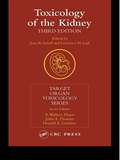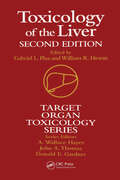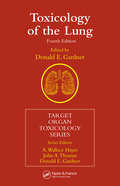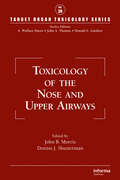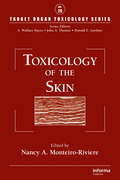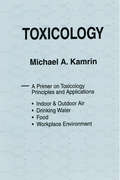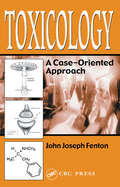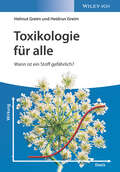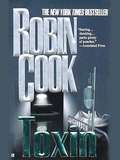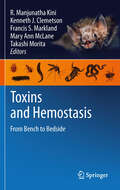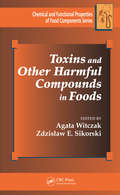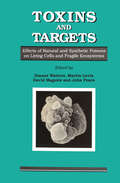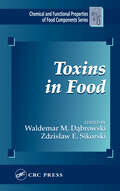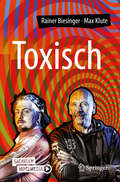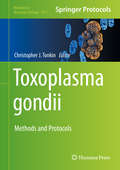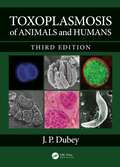- Table View
- List View
Toxicology of Fishes
by Kristine L. Willett Neelakanteswar AluruThis up-to-date, comprehensive toxicology handbook is devoted to the effects of environmental pollution on fish. Fish species represent nearly half of all vertebrates and have become important sentinels for environmental contamination and model organisms for understanding adverse outcomes from exposures. This new edition is written by recognized experts, and it highlights the significant research progress in fish toxicology that has resulted from rapid technological developments in analytical, biochemical, and genomic sciences. The book: Discusses fundamental topics such as toxicokinetics in fishes, processes governing biotransformation within these organisms, and reactive oxygen species and oxidative stress. Explains key target organ systems for chemical impacts in fish, such as the nervous and immune systems, and how fishes can develop resistance to chemical toxicity. Covers multi-transgenerational effects on fishes, epigenetics, proteomics and metabolomics, and adverse outcome pathways. Replacing the case studies in the first edition, this update delves into the impacts of microplastics, pharmaceuticals, and oil spills in dedicated final chapters. With nearly 200 illustrations and tables, this comprehensive reference work presents concepts in a way that is useful for both novices to and experts in the field of fish toxicology.
Toxicology of Glutathione Transferases
by Yogesh C. AwasthiSince the discovery of Glutathione S-Transferase (GST) or Glutathione transferase, studies have probed important questions about its pharmacological and physiological significance. Toxicology of Glutathione Transferases is the only text that details the methods used in GST research. With chapters written by experts who have been involved in
Toxicology of Herbal Products
by Olavi Pelkonen Pierre Duez Pia Maarit Vuorela Heikki VuorelaThis volume provides a comprehensive overview of the hazards inherent in herbal medicinal products, with systematic coverage of major toxicities. Topics include composition and quality control, toxicokinetics, interactions, safety pharmacology, approaches to studying complex mixtures including metabolomics and systems network pharmacology, and long-term toxicity. The volume also discusses various organ toxicities with a special emphasis on basic mechanisms of actions and the multicomponent and multi-target nature of herbal products. It concludes with a look to future challenges and opportunities. With contributions from noted experts, Toxicology of Herbal Products is a necessary resource for physicians, pharmacists, and toxicologists interested in complex plant-derived products.
Toxicology of Nanoparticles: Insights from Drosophila
by Namita Agrawal Prasanna ShahThis book offers an unparalleled source of information on in vivo assessment of nanoparticle toxicity by using Drosophila as a model organism. Nanoparticles have emerged as an useful tool for wide variety of biomedical, cosmetics, and industrial applications. However, our understanding of nanomaterial-mediated toxicity under in vivo condition remains limited. The book begins with a chapter on synthesis and characterization of nanoparticles used for various biological, medical and commercial purposes. The rest of the chapters deal with the impact of nanoparticles on different biological aspects like behavior, physiology and metabolic homoeostasis using Drosophila as a model organism. Lastly, the book summarizes how proper characterization and evaluation of safe dosage of nanoparticles can be a boon if incorporated in consumer goods and for biomedical applications.Overall, the book pursues an interdisciplinary approach by connecting nanotechnology and biology from various angles using Drosophila as a model system, so as to develop more efficient, safe and effective use of nanoparticles for human beings.
Toxicology of Organophosphate Poisoning: New Insights
by Tanu Jindal Anuj RanjanThis book addresses the consequences of high agricultural pesticide use over the last few decades in the form of organophosphate poisoning. The authors provide a background overview of organophosphate compounds, their environmental toxicity, non-target exposures and cases of human poisoning. The authors also compile and analyze data from the last two decades to demonstrate the toxicological aspects of organophosphates, and how they can pose a threat to human health. Readers will learn about the clinical manifestation of organophosphate exposure in humans, as well as the enzymatic pathways and mechanisms by which organophosphates are processed in the body and cause harm. The book concludes by providing techniques, practices and recommendations for how to manage organophosphate exposure and poisoning. It will be useful for clinicians and public health professionals, scientists, medical practitioners, researchers and environmental toxicologists.
Toxicology of Skin
by Howard I. MaibachToxic injury to the skin in the general population, and particularly in western populations, is on the increase. This is partly due to the expanding number of natural and man-made chemicals present in our everyday environment. The need for a thorough understanding of the skin, and the mechanisms of toxicity therein, has never been more pressing. Th
Toxicology of the Gastrointestinal Tract, Second Edition (Target Organ Toxicology Series)
by Shayne Cox GadThe gastrointestinal tract is the most important of the three major routes of entry (and clearance) of xenobiotics and biologic entities into the bodies of mammals. As such, it is also the major route for administration of pharmaceuticals to humans. Gastrointestinal Toxicology, Second Edition describes the mechanism for entry and clearance of xenobiotics, as well as the barriers, immunologic and metabolic issues, and functions present in the GI tract. Appearing in this volume are also considerations of the microbiome and its actions and influence on the function of the GI tract and on the toxicity and pharmacodynamics of ingested substances (including nutrients, toxins, and therapeutics). These fifteen chapters written by experienced experts in the field address methods to evaluate GI function; specifics of GI function and toxicity assessment in canines and minipigs; classes of compounds with their toxicity; species differences; and the toxicity (and promise) of nanoparticles. Those needing to understand the structure, function, and methods of studying the GI tract will find this volume a singular source of reference.
Toxicology of the Kidney
by Ferdinand Rodriguez Christopher K. Ober Lynden Archer Ferdinand CohenThe kidney plays a vital role in certain endocrine functions. Abnormalities caused by toxic chemicals or other interventions can have profound effects on these functions and consequently, on total functions. Toxicology of the Kidney, Third Edition is updated to reflect the latest research in this field and focuses on the correlation between anatomy
Toxicology of the Liver (Target Organ Toxicology Series)
by Gabriel L. Plaa William R. HewittThis second edition looks at the physiologic, biochemical, and morphologic characteristics of hepatotoxicity and includes an analysis of techniques in molecular biology and immunochemistry, among others contributing to the growth in understanding of the toxic events involved. It focuses on clinical characterization of chemical hepatotoxicity, micro
Toxicology of the Lung (Target Organ Toxicology Series)
by Donald E. GardnerThe most up-to-date treatment of inhalation toxicology available, Toxicology of the Lung, Fourth Edition examines the subject from a target-organ perspective. Completely revised and updated, the book includes contributions from an entirely new set of authors, each of them a leading international authority in their respective specialties. As with th
Toxicology of the Nose and Upper Airways
by John B. Morris Dennis J. ShustermanThe application of molecular biologic methods, recognition of neurogenic inflammatory processes, and utilization of genetic knockout animals are just some of the advances in toxicology of the upper airways in recent years. Toxicology of the Nose and Upper Airways presents a culmination of knowledge gained as a result of both human and experimental
Toxicology of the Skin (Target Organ Toxicology Series)
by Nancy A. Monteiro-RiviereThis key volume of the Target Organ Toxicology Series provides a fresh and modern approach to the subject of skin toxicology from the perspective of how the skin forms a barrier that protects the body from the external environment and how chemicals and drugs interact with the barrier properties of the skin. Any defects or perturbations to this barr
Toxicology-A Primer on Toxicology Principles and Applications
by Michael A. KamrinDifferent from other books, this unique volume presents basic toxicology principles and applications in a sophisticated yet nontechnical style. It provides an understanding of both the strengths and limitations of the discipline of toxicology and its benefits. This primer is valuable for virtually any non-toxicologist.
Toxicology: A Case-Oriented Approach
by John Joseph FentonREAL-LIFE CASES, TUTORIAL QUESTIONS, NARRATIVE HISTORYIntriguing anecdotal pedagogy, like the alleged arsenical poisonings of Napoleon and President Taylor and the probable mercury overdose of Isaac Newton, is one of the things that set Toxicology: A Case-Oriented Approach apart from other toxicology texts. Based on an undergraduate-graduat
Toxikologie für Einsteiger
by Holger Barth Katharina Ernst Panagiotis PapatheodorouIn diesem kurzen Lehrbuch werden grundlegende wissenschaftliche und klinische Aspekte der Toxikologie dargestellt und ihre wichtigsten Inhalte, Ziele und Aufgaben beschrieben. Das Buch richtet sich an Studierende biowissenschaftlicher und chemischer Bachelor- und Masterstudiengänge, die Toxikologie als medizinisches Wahlfach belegen. Zu Beginn werden wichtige toxikologische Fachbegriffe definiert, um den Einstieg zu erleichtern. Es wird beschrieben was ein „Gift“ ausmacht und wie Giftstoffe in den menschlichen Körper gelangen können. Akute Vergiftungen, ihre Ursachen und die wichtigsten Maßnahmen für ihre Therapie werden im Einzelnen vorgestellt. Der Großteil des Lehrbuches beschreibt die Wirkung ausgewählter, medizinisch relevanter Giftstoffe aus Natur und Umwelt, häuslicher Umgebung und dem Arbeitsplatz wie Toxine aus Tieren, Pflanzen, Pilzen und Bakterien, Giftgase, Stäube, Metalle, Pestizide, Lösungsmittel und Alkohol. Am Ende werden die grundlegenden Prinzipien der chemischen Kanzerogenese zusammengefasst und die krebsauslösende Wirkung einiger toxikologisch wichtiger Substanzen exemplarisch vorgestellt sowie rechtliche Grundlagen im Umgang mit Giftstoffen zusammengefasst.
Toxikologie für alle: Wann ist ein Stoff gefährlich?
by Helmut Greim Heidrun GreimWas man über Giftstoffe, deren Wirkung und Bewertung wissen muss: Zwei erfahrene Toxikologen erklären allgemeinverständlich, wann ein Stoff zum Schadstoff wird. Der Schwerpunkt liegt dabei auf den allgemeinen Grundlagen einer toxikologischen Untersuchung und Bewertung von Schadstoffen, sowie den daraus abgleiteten Handlungsempfehlungen. Anhand bekannter Beispiele aus den letzten Jahren, u. a. des Unkrautvernichters Glyphosat oder des Insektizids Fipronil, die beide in Nahrungsmitteln nachgewiesen wurden, wird erläutert, wie konkrete Gesundheitsgefährdungen anhand toxikologischer Daten und Verfahren ermittelt und welche Maßnahmen zum Schutz der Gesundheit daraus abgeleitet werden. Die Anwendung der toxikologischen Verfahren für die Bewertung von Gesundheitsrisiken wird anhand von Beispielen aus dem Alltag anschaulich dargestellt, von Lebensmitteln über Kosmetika bis hin zu Arzneimitteln und Alltagsprodukten. Ein kompakter, aber fundierter Einstieg in ein wichtiges und oft kontrovers diskutiertes Thema - für alle, die Toxine und deren Wirkungen auf Mensch und Umwelt verstehen wollen.
Toxikologie und Rechtskunde: Kompetenzfördernde Wissensvermittlung der Gefahrstoffkunde
by Peter-Jürgen KramerAuf dieses Buch haben Lehrende und Studierende in Chemie, Biochemie, aber auch in anderen chemienahen Fachgebieten lange gewartet. Dieses Buch ist ideal für Lehrende und Studierende im Fach Gefahrstoffkunde an Hochschulen und Universitäten, denn es bietet ihnen das Rüstzeug für die Gestaltung erfolgreicher Lehrveranstaltungen bzw. für einen erfolgreichen Abschluss in diesem Studienfach.Die Besorgnis, dass chemische Stoffe eine Gefährdung für die Gesundheit der Menschen und ihrer Umwelt darstellen können, ist begründet. Chemische Stoffe können schädigen, und daher gefährlich sein. Die zahlreichen Berichte von dramatischen Chemieunfällen und Umweltkatastrophen wie die von Seveso (1976) und Basel (1986) sind präsent und prägen das Bewusstsein in Gesellschaft und Politik. Nach den Gründen, warum die Geschichten katastrophaler Chemieunfälle in der Vergangenheit liegen und in heutiger Zeit in der europäischen Welt nicht mehr vorgekommen sind, wird jedoch selten gefragt.Dabei ist die Antwort auf diese Frage einfach: Die in der Chemie arbeitenden Menschen und die Behörden haben gelernt, mit den Gefährdungen und Risiken, die von chemischen Stoffen ausgehen, kompetent umzugehen. Die angewandte Wissenschaft, die diese Kompetenz vermitteln muss, ist die Gefahrstoffkunde, eine Kombination aus Toxikologie und Rechtskunde, im Studium ein Pflichtfach für jede Chemikerin und jeden Chemiker, aber auch für weitere Studiengänge, bei denen chemische Stoffe eine wichtige Rolle spielen. Der mit dem erfolgreichen Abschluss im Fach Gefahrstoffkunde verbundene amtliche Sachkundenachweis muss auch nach dem Studium regelmäßig aktualisiert werden.
Toxin (Paperback Bestsellers Ser.)
by Robin CookNewly divorced surgeon Dr. Kim Regis is determined to remain a good father to his only son, Selden. On a special night out, Kim takes Seldon to his favorite fast-food restaurant for a feast of burgers and fries. <P><P>But the good time turns to tragedy: the young boy becomes gravely ill and dies as a result of poisoning by E. coli. bacteria found in the meat. <P> Was Seldon's death a result of shoddy food-handling practices? Or was it a sophisticated case of product tampering - by a rival fast-foot giant or a disgruntled employee? Or perhaps by someone with a score to settle with Kim? Taking a leave from his surgical practice, Kim devotes his energies to solving the mystery full time. But he immediately hits a brick walls: a code of silence more impenetrable than anything he has ever encountered in his medical career. Instead of a cold-shoulder reception, however, Kim is soon met with a boot and a fist as thugs attempt to quash his inquiry. <P> Aided by his ex-wife, Kim pursues a trail of deadly evidence, uncovering complicity and guilt stretching from the slaughterhouse floor to the corporate boardroom. Racing against time before more are poisoned, the two come face-to-face with the shocking and elusive truth. And in their life-and-death search for answers, they rediscover the reasons they first fell in love. <P> With trademark pulse-pounding flair, Robin Cook delivers a cutting-edge thriller, borrowing from today's fears and tomorrow's medical technology.
Toxins and Hemostasis
by Francis S. Markland Kenneth J Clemetson Mary Ann Mclane R. Manjunatha Kini Takashi MoritaCirculation of blood is vital for the survival of vertebrates, including man. Mainly, it plays an important role in carrying food nutrients and oxygen to every tissue and organ and in removing all waste products and carbon dioxide. Any imbalance in the hemostatic and cardiovascular systems can lead to death and severe debility. A number of animals have developed mechanisms to target these systems and exploit the vulnerability. In some species (for example, snakes), such mechanisms are used to immobilize and kill the victim/prey, whereas in others (for example, insects, such as leaches, mosquitoes and ticks), they are used to provide a continuous supply of blood. These mechanisms include, but are not limited to, procoagulant and anticoagulant actions that affect the coagulation cascade and platelet aggregation, as well as altering vasodilatory responses. In all these various animals, these mechanisms have evolved to perfection over millions of years to support their survival. In last 3-4 decades, due to the efforts of scientists from various backgrounds including biology, protein chemistry, molecular biology, pharmacology, hematology, and structural biology, significant progress in understanding the structure-function relationships, as well as the mechanism of action have been made in a number of exogenous factors that affect blood coagulation, platelet aggregation and vasodilation from various animals. These exogenous factors have contributed significantly to the development of research tools as well as providing new therapeutic agents. With the increase average age of the population coupled with changes in life style in recent years, there has been a significant increase in cardiovascular and hematological disorders. Thus scientists in both academic institutions as well as the pharmaceutical industry are developing better therapeutic agents to improve the quality of life. This impetus has lead to the search for novel agents from various sources that interfere with cardiovascular and hematalogical processes. Although at first glance exogenous factors appear to function as 'villains', several life-saving drugs have been developed based upon these factors. Such drugs or drug leads include those that inhibit the angiotensin converting enzymes (Captopril and Enalapril), that block platelet receptors (Eptifibatide and Tirofiban), or that digest thrombotic plugs (Alfimeprase and bat plasminogen activator) to name a few. Several new and exciting success stories are currently unfolding. In this book, recent studies on some of the exogenous factors that play crucial roles in cardiovascular and hematological disorders are reviewed in order to consolidate the efforts in this area of research and to recruit new, talented researchers. The 25-30 review chapters, each written by experts in their field, compiled herein are devoted to exogenous factors affecting platelet aggregation, anticoagulant and procoagulant proteins, fibrinolytic proteins and hypotensive agents (For details see, Contents of the Book). This book is intended to help to create elevated awareness and enthusiasm in the field of exogenous factors. I believe that this book will provide greater impetus to the search for novel proteins based on naturally occurring exogenous factors. This will be the first book dealing extensively with exogenous factors in the last 25 years. The book will provide a ready reference to the different approaches used to solve complex problems in protein chemistry and pharmacology of exogenous factors. The book will update our understanding of the structure-function relationships and mechanisms of action of exogenous factors and provide great insights into future directions for solving the remaining challenges.
Toxins and Other Harmful Compounds in Foods (Chemical & Functional Properties of Food Components)
by A. Witczak Zdzislaw SikorskiToxins and Other Harmful Compounds in Foods provides information on the contents, distribution, chemical properties, and biological activity of toxins and other harmful compounds in foods that are natural components of the raw materials, accumulated due to microbial actions and environmental pollution, or are generated due to processing. This book shows how different factors related to the production of raw materials, as well as to storage and processing conditions, affect the presence and concentration of toxins and other harmful compounds in foods. It shows how various regulations, as well as unit operations and processes used in food production, may eliminate different toxins or generate new ones. The real health hazards for the consumers resulting from the presence of toxic/harmful compounds in aliments are discussed, and various national and international regulations obligatory in agriculture and industry aimed at increasing food safety are presented. Methods of analysis used for detection and determination of undesirable compounds are also discussed, making it possible to understand the effect of storage and processing parameters, as well as systems of quality assurance, on food safety and to select optimum procedures for analytical control.
Toxins and Targets
by David Maguire Dianne Watters John Pearn Martin LavinFirst Published in 1992. The last decade of the twentieth century has seen an unprecedented advocacy for the preservation of a safe environment, and the prevention of ill-health from toxic chemicals. Human activity, however, is responsible for introducing new toxins into the environment. In order to control competitors for human food sources, an armament of pesticides has been assembled and their widespread and largely uncontrolled application has been permitted. It is only when the health of the population begins to suffer from the effects of these chemicals that the efficacy of their use is questioned. Decision-makers whose roles involve the promotion and control of the environment must look to lessons that can be learnt from biosystems that include animals other than man. Toxins and Targets details the way in which organisms from diverse habitats in the plant and animal kingdoms have adapted to handle toxins safely. Part I, on the aquatic environment, highlights the means by which marine organisms have adapted their toxins to be effective in a world of high aqueous solubility and infinite dilution. Part II deals with venomous terrestrial organisms and the mechanisms by which they damage animal cells, and Part III considers the way in which human society attempts to investigate toxicity and to control both synthetic and naturally occurring poisons. The development of a safe environment depends on increased knowledge and novel approaches to solving escalating problems. This book is a step towards this end.
Toxins in Food
by Waldemar M. Dąbrowski Zdzisław E. SikorskiWhile systems such as GMP and HACCP assure a high standard of food quality, foodborne poisonings still pose a serious hazard to the consumer's health. The lack of knowledge among some producers and consumers regarding the risks and benefits related to food makes it imperative to provide updated information in order to improve food safety.To
Toxisch
by Rainer Biesinger Max KluteDurch den Konsum von Rauschdrogen ballern sich tagtäglich Millionen von Menschen aus ihrer subjektiv gefühlten Realität heraus. Angefangen bei Alkohol und Nikotin haben wir es heute mit einem verantwortungslosen, unkultivierten und gefährlichen Konsumverhalten zu tun. Dieses Buch stellt die durchaus erlaubte und provokative Frage, ob die derzeitige Drogenpolitik noch „up to date“ ist, bzw. wo sie durch ihre restriktive Herangehensweise nicht völlig versagt hat!? Wo liegen die Ursachen dieses Konsumverhaltens und wie ist es um einen liberalisierten und aufgeklärten Umgang mit gewissen Substanzen bestimmt? Mit diesem mutigen und investigativen Werk nehmen die beiden Autoren eine authentische Perspektive zum Thema Rauschdrogen in Deutschland ein. Und sie wissen, wovon sie reden! Ein Buch für User, Neugierige, Eltern, Pädagogen, Therapeuten, Ärzte, Sozialarbeiter, Interessierte der Drogenverbotsdebatte und alle, denen etwas daran liegt, dass die Gesellschaft in Sachen Suchtprävention und Selbstbestimmungsrecht von Konsumenten endlich wach wird und handelt.Inklusive Videointerviews mit den Autoren und Geleitworte von Kriminalbiologe Dr. Mark Benecke, Jugendrichter Andreas Müller und dem Grimme-Preisträger $ick.
Toxoplasma gondii: Methods and Protocols (Methods in Molecular Biology #2071)
by Christopher J. TonkinThis volume covers a diverse collection of protocols currently being used by the Toxoplasma research community, and also looks at innovative methods that are pushing the boundaries of possibilities. Chapters in this book discuss topics such as isolation and genotyping of Toxoplasma gondii strains; assessing rhoptry secretion in T. gondii; plate-based quantification of stimulated Toxoplasma egress; methods to study ocular toxoplasmosis; and metabolic analysis of Toxoplasma gondii tachyzoites. Written in the highly successful Methods in Molecular Biology series format, chapters include introductions to their respective topics, lists of the necessary materials and reagents, step-by-step, readily reproducible laboratory protocols, and tips on troubleshooting and avoiding known pitfalls.Cutting-edge and thorough, Toxoplasma gondii: Methods and Protocols is a valuable resource for students or groups starting off in the field, as well as laboratories interested in implementing the latest techniques described in the book.
Toxoplasmosis of Animals and Humans
by J. P. DubeyThis is the only book to cover toxoplasmosis of animals and humans thoroughly in one single source. Found worldwide from Alaska to Australasia, Toxoplasma gondii is the cause of one of the most common parasitic infections in humans, livestock, companion animals, and wildlife, and is included on the list of potential bioterrorism microbes. Furthermore, T. gondii has been and continues to be used extensively as a model for the cell biology of apicomplexan parasites. In the decade since the second edition of this book was published, there has been an explosion of knowledge concerning the parasite Toxoplasma gondii and toxoplasmosis. This update provides unique information on all known host types for this parasite, with an additional chapter on history, substantial updates throughout, and a detailed focus on the biology of the parasite in Chapter 2. The third edition is compiled by author JP Dubey, an authority on T. gondii who has worked with virtually all hosts of the protozoan during the last 55 years, including humans, all livestock species, wildlife, and zoo animals. The book distills the voluminous and potentially confusing scientific literature, that has grown geometrically in the 30+ years since the publication of the first edition, into a comprehensive resource for all professionals, graduate students and researchers working in this field.
